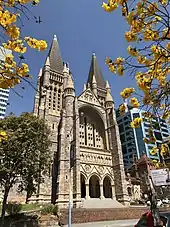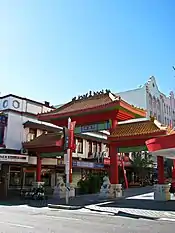Demographics of Brisbane
Brisbane (/ˈbrɪzbən/ (![]() listen))[1] is the capital of and most populous city in the Australian state of Queensland,[2] and the third most populous city in Australia. The Australian Bureau of Statistics estimates that the population of Greater Brisbane is 2,462,637 as of June 2018,[3] and the South East Queensland region, centred on Brisbane, encompasses a population of more than 3.6 million.[4] The Brisbane central business district stands on the original European settlement and is situated inside a bend of the Brisbane River, about 15 kilometres (9 miles) from its mouth at Moreton Bay.[5] The metropolitan area extends in all directions along the floodplain of the Brisbane River Valley between Moreton Bay and the Great Dividing Range, sprawling across several of Australia's most populous local government areas (LGAs), most centrally the City of Brisbane, which is by far the most populous LGA in the nation. The demonym of Brisbane is Brisbanite.
listen))[1] is the capital of and most populous city in the Australian state of Queensland,[2] and the third most populous city in Australia. The Australian Bureau of Statistics estimates that the population of Greater Brisbane is 2,462,637 as of June 2018,[3] and the South East Queensland region, centred on Brisbane, encompasses a population of more than 3.6 million.[4] The Brisbane central business district stands on the original European settlement and is situated inside a bend of the Brisbane River, about 15 kilometres (9 miles) from its mouth at Moreton Bay.[5] The metropolitan area extends in all directions along the floodplain of the Brisbane River Valley between Moreton Bay and the Great Dividing Range, sprawling across several of Australia's most populous local government areas (LGAs), most centrally the City of Brisbane, which is by far the most populous LGA in the nation. The demonym of Brisbane is Brisbanite.
Country of Birth
| Country of birth | Population (2016) |
|---|---|
| 106,053 | |
| 90,086 | |
| 36,175 | |
| 35,335 | |
| 22,068 | |
| 20,797 | |
| 16,731 | |
| 12,202 | |
| 11,976 | |
| 11,691 | |
| 10,765 |
The 2016 census showed that 32.2% of Brisbane’s inhabitants were born overseas.[7] 50.9% of inhabitants had at least one parent born overseas.[8] Of inhabitants born outside of Australia, the four most prevalent countries of birth were New Zealand, England, Mainland China, and India.[9] Brisbane has the largest New Zealand and Taiwanese-born populations of any city in Australia.[10]
Languages
At the 2016 census, 78% of inhabitants spoke only English at home,[11] with the next most common languages being Mandarin (2.4%), Vietnamese (1.0%), Cantonese (0.9%), Spanish (0.7%), Hindi (0.6%), Samoan (0.6%), Korean (0.6%) and Punjabi (0.6%).[12]
Ancestry
At the 2016 census, the most commonly nominated ancestries were:[N 1][13]
- English (39.7%)
- Australian (34.6%)[N 2]
- Irish (13.2%)
- Scottish (11%)
- German (6.4%)
- Chinese (4.7%)
- Italian (2.8%)
- Indian (2.6%)
- Indigenous (2.4%)[N 3]
- Dutch (1.7%)
- New Zealander (1.7%)
- Maori (1.5%)
- Filipino (1.3%)
- Vietnamese (1.2%)
Religion

At the 2016 census, the most commonly cited religious affiliations was 'No religion' (30.6%).[16]
Brisbane's most popular religion at the 2016 census was Christianity, and the most popular denominations were Catholicism (21.5%) and Anglicanism (13.3%). Other Christian denominations including Uniting Church, Baptists, Pentecostalism, Lutheranism and Eastern Orthodox made up 18.8% of the population.[17] All Christian denominations totalled 53.6% of the population. Brisbane's CBD is home to two cathedrals — St John's (Anglican) and St Stephen's (Catholic).
The most popular non-Christian religions at the 2016 census were Buddhist (2%), Muslim (1.5%) and Hindu (1.5%).[18]
Historical Populations
| Historical populations | ||||||||||||||||||||||||||||||||||||||||||||||||||||||||||||||||||
|---|---|---|---|---|---|---|---|---|---|---|---|---|---|---|---|---|---|---|---|---|---|---|---|---|---|---|---|---|---|---|---|---|---|---|---|---|---|---|---|---|---|---|---|---|---|---|---|---|---|---|---|---|---|---|---|---|---|---|---|---|---|---|---|---|---|---|
| ||||||||||||||||||||||||||||||||||||||||||||||||||||||||||||||||||
Notes
- As a percentage of 2,122,578 persons who nominated their ancestry at the 2016 census.
- The Australian Bureau of Statistics has stated that most who nominate "Australian" as their ancestry are part of the Anglo-Celtic group.[14]
- Of any ancestry. Includes those identifying as Aboriginal Australians or Torres Strait Islanders. Indigenous identification is separate to the ancestry question on the Australian Census and persons identifying as Aboriginal or Torres Strait Islander may identify any ancestry.[15]
- Sources: Queensland Treasury (1826-1891), Australian Bureau of Statistics (1901 onwards). Capital cities based on Greater Capital City Statistical Areas (GCCSAs) for 1971 onwards. Populations for previous years are based on earlier boundaries and may be inconsistent with GCCSAs. Pre-1971 may not include the Indigenous population.
References
- Macquarie Dictionary. The Macquarie Library. 2003. p. 121. ISBN 1-876429-37-2.
- "Brisbane (entry 4555)". Queensland Place Names. Queensland Government. Retrieved 14 March 2014.
- "Main Features - Main Features". 25 March 2020.
- "Main Features - Main Features". 25 March 2020.
- "Brisbane and Greater Brisbane". Queensland Places.
- "2016 Census Community Profile – Greater Brisbane (3GBRI – GCCSA)". Australian Bureau of Statistics.; , ZIPed Excel spreadsheet. Table G09e & G09f
- "2016 Census QuickStats: Greater Brisbane".
- "2016 Census QuickStats: Greater Brisbane".
- "2016 Census QuickStats: Greater Brisbane".
- "2016 Census Community Profile – Greater Brisbane (3GBRI – GCCSA)". Australian Bureau of Statistics.; , ZIPed Excel spreadsheet. Table G09e & G09f
- "2016 Census QuickStats: Greater Brisbane".
- "2016 Census Community Profile – Greater Brisbane (3GBRI – GCCSA)". Australian Bureau of Statistics.; , ZIPed Excel spreadsheet. Table G13e & G13f
- "Archived copy". Archived from the original on 14 July 2017. Retrieved 1 July 2017.CS1 maint: archived copy as title (link)
- Statistics, c=AU; o=Commonwealth of Australia; ou=Australian Bureau of (January 1995). "Feature Article - Ethnic and Cultural Diversity in Australia (Feature Article)". www.abs.gov.au.
- "Archived copy". Archived from the original on 14 July 2017. Retrieved 1 July 2017.CS1 maint: archived copy as title (link)
- "Archived copy". Archived from the original on 14 July 2017. Retrieved 1 July 2017.CS1 maint: archived copy as title (link)
- "Archived copy". Archived from the original on 14 July 2017. Retrieved 1 July 2017.CS1 maint: archived copy as title (link)
- "Archived copy". Archived from the original on 14 July 2017. Retrieved 1 July 2017.CS1 maint: archived copy as title (link)
- "3105.0.65.001 - Australian Historical Population Statistics, 2016". Australian Bureau of Statistics. 18 April 2019. Retrieved 23 June 2019. Table 3.1, Capital City(b), 1901 onwards
- "Historical tables, demography, 1823 to 2008 (Q150 release)". Queensland Treasury. 2009. Archived from the original on 1 April 2019. Retrieved 23 June 2019. Table D1, Population by capital city and rest of state, Queensland, 1823 to 2007
